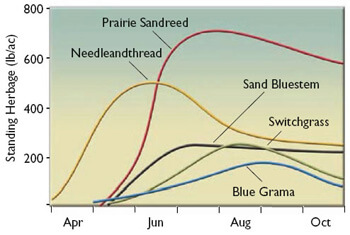Understanding the interactions of livestock, plants, and precipitation is key to managing drought risk on the ranch.

Grazing management influences the effectiveness of precipitation. Plant cover and healthy root systems result in better infiltration of moisture into the soil. Overgrazing can cause drought-like conditions even with average precipitation.
Rangeland in good condition has a diversity of plant species, which extends the time window when high quality forage is available for grazing, provides opportunities for forage production during limited and irregular precipitation, and decreases the likelihood that any one species will be overgrazed.
The effects of drought are intensified at poorer range conditions. Rangeland in fair condition is often more severely affected by drought than rangeland in good to excellent condition. Range condition also influences the rate of recovery in forage production after drought.

Seasonal distribution of current-year herbage by species on sandy range sites in good to excellent range condition with average precipitation. (Nosal 1983)
Stocking rate and grazing system decisions are most likely to affect animal performance in the second half of the grazing season. In contrast, these decisions are most likely to affect plant vigor and herbage production potential during the first half of the next summer grazing season.